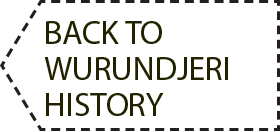
William Barak and Bunjil. Photographer: Ash Kerr-Firebrace for Chisholm Institute
2. Pre-Contact Wurundjeri
The Wurundjeri people of the Kulin Nation are the Traditional Owners of the land that is now known as the City of Yarra. Their relationship with the land extends back tens of thousands of years to when their creator spirit ‘Bunjil’ formed their people, the land and all living things. The Wurundjeri mainly spoke Woi wurrung language, but also spoke other languages of their nation. Each clan was governed by a Ngurungaeta (pronounced na-run-getta) or head-man.
Australia’s state and territory borders have existed for a relatively short period. For thousands of years before European settlement, the country now known as Australia consisted of 500 – 700 Aboriginal nations, each with their own systems of government, cultural practices, religions and languages. Part of the area now known as the City of Melbourne and all of the City of Yarra (as well as land extending north into central Victoria) are the traditional lands of the Kulin nation. The City of Yarra area was looked after by the Wurundjeri-willam family group. They belong to the Wurundjeri-balluk clan, which is part of the larger Wurundjeri tribe. The Wurundjeri-willam mainly spoke Woi wurrung language, but also spoke other languages of their nation. Each clan was governed by a Ngurungaeta [pronounced na-run-getta] or head-man.
All clan members knew their land in great detail, including the best times to visit each area according to weather and availability of food. In winter, the Wurundjeri-willam regularly camped in the higher areas as the land near the river flooded. In spring and summer they travelled more frequently, moving between nine and sixteen kilometres a day, hunting and gathering food, and visiting sacred sites. According to historian Penelope Edmonds, ‘Spring and early summer were times of movement and change, for it was then that crops such as yam (mirr-n’yong) were ready for harvesting, birds’ eggs plentiful and wildfowl and game more accessible. As summer wore on the Aborigines visited fishing and eeling sites and camped for longer periods.’[i]
Land boundaries for each clan were clearly defined, with strict protocols governing access to the land of other clans. While each clan or family group travelled on its own, they still maintained relationships with others within their language group. Marriage played an important role in this, as people would not marry within their own clan. Instead, partners were chosen from different clans within the Kulin nation.[ii] Visiting the land of other clans was therefore an important and necessary right.
Ties were also cemented through gatherings and corroborees, where clans within the Kulin Nation would meet, with sometimes hundreds of people together. Corroboree dances and storytelling performances were a focus of these gatherings, with different clans often competing to outdo each other. These gatherings were also an opportunity for a council of Ngurungaeta to be formed to settle disputes or decide on punishment for those responsible for serious crimes against Aboriginal law.
[i] Christie, Aborigines in Colonial Victoria, 9
[ii] Presland, First People, 15
Australia’s state and territory borders have existed for a relatively short period. For thousands of years before European settlement, the country now known as Australia consisted of 500 – 700 Aboriginal nations, each with their own systems of government, cultural practices, religions and languages. Part of the area now known as the City of Melbourne and all of the City of Yarra (as well as land extending north into central Victoria) are the traditional lands of the Kulin nation. The City of Yarra area was looked after by the Wurundjeri-willam family group. They belong to the Wurundjeri-balluk clan, which is part of the larger Wurundjeri tribe. The Wurundjeri-willam mainly spoke Woi wurrung language, but also spoke other languages of their nation. Each clan was governed by a Ngurungaeta [pronounced na-run-getta] or head-man.
All clan members knew their land in great detail, including the best times to visit each area according to weather and availability of food. In winter, the Wurundjeri-willam regularly camped in the higher areas as the land near the river flooded. In spring and summer they travelled more frequently, moving between nine and sixteen kilometres a day, hunting and gathering food, and visiting sacred sites. According to historian Penelope Edmonds, ‘Spring and early summer were times of movement and change, for it was then that crops such as yam (mirr-n’yong) were ready for harvesting, birds’ eggs plentiful and wildfowl and game more accessible. As summer wore on the Aborigines visited fishing and eeling sites and camped for longer periods.’[i]
Land boundaries for each clan were clearly defined, with strict protocols governing access to the land of other clans. While each clan or family group travelled on its own, they still maintained relationships with others within their language group. Marriage played an important role in this, as people would not marry within their own clan. Instead, partners were chosen from different clans within the Kulin nation.[ii] Visiting the land of other clans was therefore an important and necessary right.
Ties were also cemented through gatherings and corroborees, where clans within the Kulin Nation would meet, with sometimes hundreds of people together. Corroboree dances and storytelling performances were a focus of these gatherings, with different clans often competing to outdo each other. These gatherings were also an opportunity for a council of Ngurungaeta to be formed to settle disputes or decide on punishment for those responsible for serious crimes against Aboriginal law.
[i] Christie, Aborigines in Colonial Victoria, 9
[ii] Presland, First People, 15


